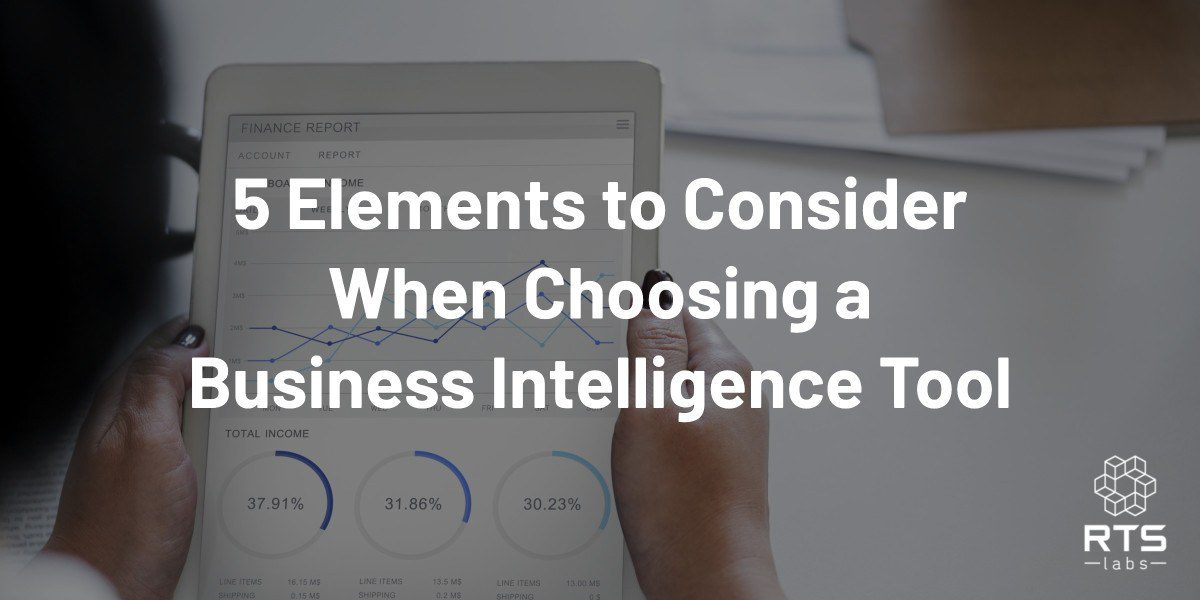Every minute of every day, your customers, potential customers, competitors, and partners are generating valuable data – data that has the potential to make or break your business. The problem is, you need a tool to help you transform that data into usable information before it can do your business any good. What you need is business intelligence (BI).
Sounds simple enough until you begin down the rabbit hole of options. As needs and methods change across industries, BI tools are also changing to address the unique needs that businesses have. You also have the option to develop a custom BI app. So, how do you choose in a seemingly endless pool of options?
There are 5 elements to consider when choosing a business intelligence tool. These five elements can tell you a lot about the specific features and capabilities you need from a BI tool as you consider user habits, budget, and other important factors.
Then, you do a little competitive research. Instead of testing solutions by trial and error, start by exploring what your competitors use. Choosing a tool and user community similar to your competitors will not only keep you informed of the latest techniques for data transformation but will also help keep you ahead of (or at least keep up with) the pack.
Which of these five elements carry the most weight as you consider a BI tool for your organization?
Social decision making
If your competitors are relying on social media and sharing apps to fuel decision-making, then a BI tool with a brainstorming module could be helpful.
The BI analysis tool you choose should be able to target important phrases and keywords. By collecting these key words and phrases, you can use your new tool to examine the data and glean new observations and insights that pertain to a specific business goal. A typical example of this practice is monitoring the flow of ideas during chats. A BI tool with an emphasis on social media collection and analysis can derive meaning from chat texts and social media feeds.
Customization
Each company has its own unique needs and follows its own path to attain its business goals. A BI vendor should be able to accomodate and create custom applications that support your individual business needs. Many solutions are not “one size fits all” – and you should probably be very wary of the ones that claim to be. Your BI tool should be flexible enough to meet your needs now and to add more capabilities as your needs change. Will the BI tools you’re considering offer enough customization for you, your users, and your organization?
How you consume data and glean insights from it will be a determining factor in a tool’s effectiveness. How a BI solution can be customized should be a big consideration. A tool that limits your ability to adapt might not yield the results and the ROI you’re hoping for. Also think about how easy it is or isn’t to customize these different BI tools. You should be able to customize all the features you want without having to waste monstrous amounts of time waiting for a vendor to fulfill your request.
Ease-of-use and the speed with which data results can be accessed also play a crucial role in your selection of a BI tool. After all, if you have to wait too long for your data, it defeats the purpose of having up-to-date info at your fingertips. Based on the complexity of your queries, results should be returned sooner rather than later. The tool’s dashboard should visually present the data in an understandable way and provide comparison scenarios. When testing BI tools, always use a test environment that contains data sets and loads that are representative of your current demands.
Integration
Does the BI tool you’re considering exist as a standalone solution or as an integrated solution? A standalone solution can be accessed inside its own application. Integrated tools work from inside a host application or a suite of applications. An example might be the dictionary of a word processor program, such as Google Docs – the dictionary is a plug-in separate from the main application.
To figure out which solution is best for you, look at your current systems. What are the variables you need to consider when it comes to people using and accessing your BI tool? What software platforms are you already using? How interconnected are your programs and applications now? What is your internet connectivity like? Do your users need to access these BI reports via mobile phone, existing web applications, and different web browsers?
One advantage of choosing an integrated solution is that users will be able to access the BI tool via an application they are already familiar with. That also means that the tool is accessible and useful to every stakeholder using pre-existing login information. On the other hand, a standalone BI solution usually requires each user to have his or her own login. Copies of the software usually must be purchased and installed on specific machines (unless it’s a cloud-based program, but even then you may be required to buy licenses).
With integrated tools, there are both fully integrated and partially integrated solutions. Fully integrated BI tools provide more security than partially integrated ones. If you choose to go with an integrated solution, make sure to dig deeper to determine if it is partially or fully integrated. Most companies will advertise integration but do not necessarily get into the specific details.
BONUS TIP: While we’re talking about it, one of the must-have integrations you may want to consider is spreadsheet integration. Spreadsheet programs can gather data from multiple sources, collate information, and create reports based on the integrated data. Data gathering and integration are always time consuming, and sometimes the integration techniques are complex. BI tools within a spreadsheet program can automate data integration from different sources, reducing manual work. That means a BI tool with strong data integration capabilities and spreadsheet integration can increase productivity and help you get more from your BI tool as you work to analyze and understand your data.
Training users
Whichever solution you choose, all users should receive training. Without proper training, users aren’t as likely to adopt whatever BI tool you choose. If people don’t use it, you won’t reap the benefits of better business intelligence reports – and you certainly won’t get the ROI you’re expecting. All BI tools offer some product training to help users get to know their product. The question is to what degree do they offer training. Is the training personalized or just a PDF manual you download from the internet? If you have questions, are there live people available to answer them – or a robust community of users who can help you?
In other words, it’s about the availability and the quality of the training. Can you get the training you need for both advanced and beginning users? Can you get training that’s customized for your organization? Find out upfront so you’re not struggling after you make your choice and start implementation.
Pricing
Finally, there’s pricing. When you compare and contrast business intelligence tools, what’s the balance of features to cost? Is it a subscription model? Are updates automatic and free? What are some of the hidden costs you’ll want to keep in mind: customer service calls, change requests, additional licenses, etc.?
Think about scaling, too. If your business grows and thus your BI needs increase, will the provider charge extra for additional user licenses or is the cost inclusive? A good vendor should help you scale properly when the time comes and have a pricing structure in place that isn’t too restrictive.
Or, if you decide to develop a custom business intelligence app in-house or with a vendor, can the app you develop support growth? Can your in-house team or your third-party vendor offer the support you need when it’s time to scale up operations? Make sure to consider this question as early as when you’re preparing your request for proposal (RFP) or planning for in-house development.
While you’re considering pricing, don’t let budget considerations stall your project. (We see it happen all the time!) Yes, any tool you choose or develop needs to be within the budget you’ve set. At the same time, your budget shouldn’t be the primary driver of your choice. How well features match your needs and how well the program can scale have to factor in. After all, if you suddenly hit some snags, such as needing to expand rapidly, your users experience accessibility issues with your BI tool, or you have to migrate to another platform down the road that’s incompatible with your BI app, you could end up incurring higher costs anyway.
So, think about price, but don’t fear paying more, if what you get in return is worth it.
[blog_shortcode id=”9428″]
What it all comes down to …
While doing your market research and examining what your competitors use are incredibly helpful, in the end you have to decide what’s right for YOU, your users and your organization. Consider the total strength of your team. Determine how many of your employees will need to use the BI tool and how often. Think about the data they really want and need.
Going through these 5 elements to consider when choosing a business intelligence tool should give you a good checklist of your needs, as well as pros and cons of individual BI apps, so you can make an objective decision with confidence.
Want more on BI? Check out this real-life success story from one of our clients.






